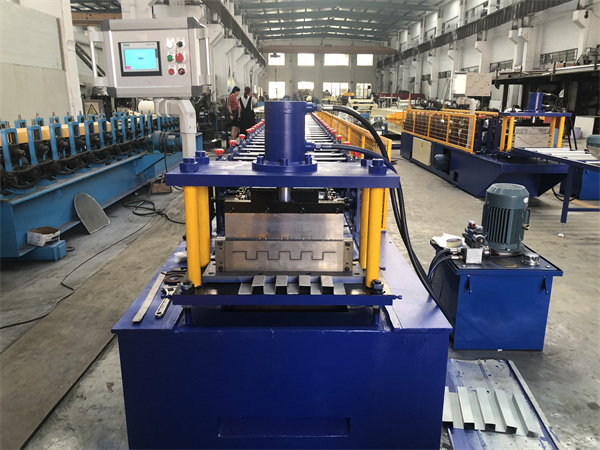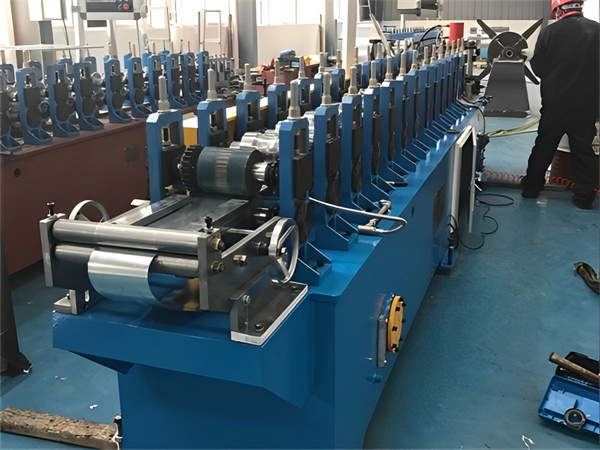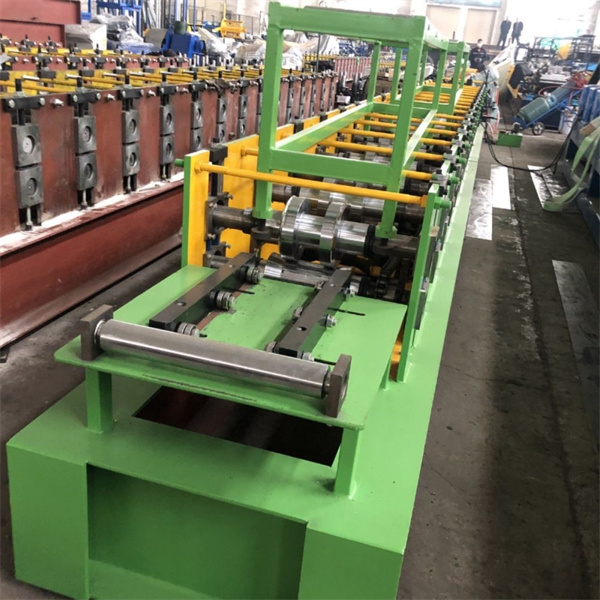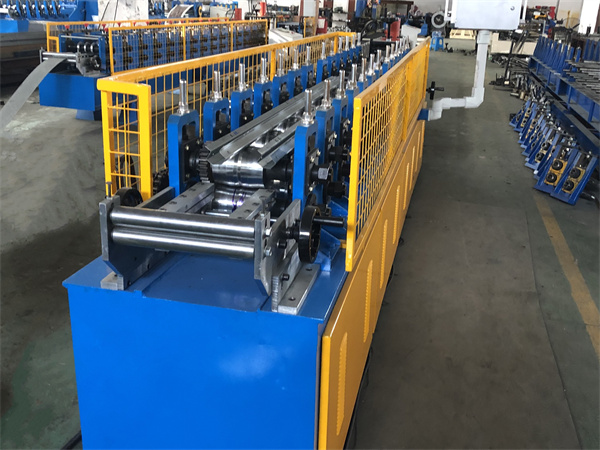Angle roll forming machines are an essential equipment for bending and forming metal sheets and plates into angle shapes for various manufacturing applications. This comprehensive guide provides a detailed overview of angle roll formers covering their working principles, types, main components, specifications, advantages, uses and applications across industries.
Overview of Angle Roll Forming Machines
Angle roll forming machines are designed to produce continuous, precise, and uniform profiled angles from metal strips and sheets. They form repetitive bends on metals to convert flat sheets into shaped angle sections.
The main advantage of angle rolling is its ability to form complex angles and curves through a series of incremental bending processes. This eliminates the need for expensive die tooling required for extruded or press brake angles. Built using robust steel frames, angle rollers provide superior durability for high production environments.
Angle rolling involves feeding a flat metal strip through a pyramid arrangement of three or four cylindrical rolls. The top roll applies pressure from above while the lower rolls support and feed the sheet. By adjusting the relative positions of the rolls, concave or convex bends can be formed in the material to create L,U and other angle shapes.
Compared to press brakes, angle roll forming is more efficient and applies less stress on metals during cold bending processes. They are ideal for prototyping and small batch production. Typical materials formed include low to high carbon steel, stainless steel, copper, brass, and aluminum.
Key advantages of angle roll forming machines:
- Continuous production of angles in long lengths
- Flexible rolling process for intricate angles and profiles
- Lower tooling costs compared to stamping or press brakes
- Applicable for shorter metal strips and sheets
- Ideal for prototypes, custom and small batch production
Typical applications of angle roll formed sections:
- Trusses, frames, brackets, channels for construction, shelters
- Automotive parts like chassis, trailers, transmission cases
- Railing, safety cages, conveyors for industrial setups
- Decorative molding, panels, enclosures for furniture and facades
- Agricultural equipment, trailers, greenhouses, harvesting machines

एंगल रोल बनाने वाली मशीनों के प्रकार
Angle rollers are available in different configurations based on orientation of the rolls, number of rollers used and loading direction of the sheets. Each variant has its own advantages and limitations depending on the bending application.
Angle Rolling Machine Types
| Machine Type | विवरण |
|---|---|
| Pyramid style | Most common 4 roll type with one top vertical roller and three lower rollers forming a pyramid. Allows complex bends. |
| 3 roll angle roller | Compact 3 roll benders with two bottom driven rolls. Limited to simple angles but cost effective. |
| Pinch roller | Designed for pre-bending sheets before final forming. Has non-driven pinching top roller. |
| 4 roll reversing | Advanced reversible 4 roll design for intricate angles. Alternates feed direction for more control. |
| Vertical angle roller | Loads sheet vertically from top. Used where floor space is limited. |
| Horizontal angle roller | Sheet enters horizontally from front. Requires more space but better for long strips. |
| Ring rolls | Use large ring dies to incrementally roll angles of large diameter pipes and tubes. |
| Section rolls | Special 2 or 3 roll stands to create complex channel, beam, rail profiles. |
| Saddle rolls | Formed using an upper and lower roller to create saddle-like arched shapes. |
| Roller leveler | Levels sheet stock before angle rolling using series of adjusting rolls. |
| Plate rolls | Designed for rolling structural grade steel plates up to 1 inch thickness. |
Comparison Between 3 Roll and 4 Roll Angle Rolling Machines
| Parameters | 3 Roll Angle Roller | 4 Roll Angle Roller |
|---|---|---|
| Roll Configuration | Two bottom rolls, one top roll | Pyramid style with 4 rolls |
| Bending Capacity | Up to 90 degrees simple bends | Complex angles and variable radii possible |
| Ease of Operation | Quick set up and operation | Requires skilled setting of roll positions |
| Cost Considerations | Lower machine cost, minimal tooling | Higher investment cost |
| Typical Applications | General purpose light fabrication | Precision metalworking, custom enclosures |
Main Components of Angle Roll Forming Machines
Angle roll forming machines are engineered with robust components to handle high forming forces and pressures involved in metal bending. Here are some of the main sub-assemblies in a typical angle rolling machine:
Angle Roller Components
- Rolls – Machined from alloy steel with hardened surfaces to withstand repetitive bending without damage. Different top and bottom roll diameters used.
- Roll bearings – Heavy duty anti-friction bearings like spherical roller or tapered bearings to take heavy loads. Sealed bearings with oil or grease lubrication used.
- Roll adjustment mechanisms – Allows precise manual or automatic repositioning of rolls using rack, hydraulic, and servo controls.
- Roll drives – Hardened steel gears or pulley drives transferring power from main motor to individual rolls.
- Sheet feeding system – Rollers or power-feed gripper mechanism for controlled material feeding.
- Main drive motor – High torque AC geared motors with variable speed control for rolling. Separate motors for feeding.
- Frame and base – Heavy rigid steel frame that resists deformation during rolling. Bolted or welded construction.
- Electrical cabinet – Houses motor drives, PLC or microprocessors, operator controls and displays.
- Safety guarding – Full enclosure guards with interlocks for operator safety.
- Controls – Pendant buttons or touchscreen for controlling roller positions and material feed.
Specifications of Angle Rolling Machines
Angle rollers have different capacities and control features depending on the model. Typical technical specifications are provided below for comparing different angle roller machines:
Angle Roller Machine Specifications
| विशेष विवरण | Typical Range |
|---|---|
| Roller Size | 50 to 320 mm diameter rolls |
| Roller Adjustment | Manual or Automatic CNC |
| Roll Drive Capacity | 3 kW to 15 kW motor power |
| Roll Speed | 10 to 45 rpm variable speed |
| Rolling Force | 50 to 2000 kN force range |
| द्रव्य का गाढ़ापन | 0.5 to 25 mm mild steel capacity |
| Formed Angles | Up to 130 degrees on steel strips |
| Machine Weight | 1500 to 8000 kg approx. |
| Control | PLC/CNC with HMI touchscreen |
Design and Layout Specifications
- Number of top and bottom rolls
- Roller adjusting range
- Open and closed heights
- Floor space and layout
- Ergonomics for feeding and unloading
- Front or rear loading of sheets
- Safety guards with interlocks
Performance Specifications
- Rolling force and torque
- Rolling speed and precision
- Feeding speed range
- Alignment precision
- Surface finish quality
- Repeatability and accuracy

Industrial Applications of Angle Roll Forming
Angle rolling process allows flexible bending of metals into a variety of angle cross-sections. Here are some of the common applications across manufacturing industries:
Angle Rolling Applications
| Industry | Typical Applications |
|---|---|
| Construction | Roof trusses, purlins, wall studs, cladding channels |
| Infrastructure | Road signs, lighting poles, traffic barriers, handrails |
| Automotive | Chassis, trailers, tipper bodies, transmission casings |
| Railways | Bogies, freight wagons, passenger coaches |
| Aerospace | Aircraft ribs and stringers, hydraulic tubes, engine cowls |
| Shipbuilding | Hull and deck fabrications, hatches, masts, railings |
| Furniture | Table frames, enclosures, decorative sections |
| कृषि | Implements, harvesters, trailers, silos, greenhouse structures |
In industrial environments, typical angle rolled parts include:
- Brackets, housings, frames, bases
- Channels, beams, specialized sections
- Conveyor guards, safety cages, ladders
- Tanks, hoppers, cylindrical segments
- Decorative molding, spinning, domes
Angle Rolling Process Capabilities
Angle roll forming allows flexible production of varied geometries through its incremental bending approach. Here are some of the common angle shapes that can be formed:
Angle Rolling Process Capabilities
| Shape | विवरण |
|---|---|
| Equal legs | 90 degree angles with legs of equal size |
| Unequal legs | L angles with unequal leg dimensions |
| Convex angles | External curved angles |
| Concave angles | Internal curved or re-entrant angles |
| Off-center angles | Asymmetric angles |
| Variable angles | Continuously changing angles |
| Small radius bends | Tight radiuses down to 10 mm |
| Heavy angles | Up to 25 mm thick sections |
| Rolling rings | Circular and elliptical shapes |
| Section rolling | Beams, channels, rails |
| Cone rolling | Truncated cones and curved segments |
Benefits and Advantages of Angle Rolling
Angle rolling process provides unique advantages compared to other metal bending methods:
Benefits of Angle Rolling
| Benefits | विवरण |
|---|---|
| No die costs | Eliminates need for expensive custom dies. Saves on tooling. |
| Fast set up | Quick and easy changeover between part configurations. |
| Material savings | Reduces wastage by incremental bending. |
| Close tolerances | Consistent tolerance control down to +/- 0.5 mm |
| No heating required | Cold forming avoids metallurgical changes from heat. |
| Finishes parts | Smoother surface than press brake bends. |
| Lower stresses | Gradual bending minimizes chances of cracks. |
| Custom parts | Easily adapt for new custom profiles. |
| Light deformation | Preserves mechanical properties of material. |
Angle Rolling Machine Manufacturers
Leading manufacturers of angle roll forming equipment include:
Top Angle Roller Manufacturers
| Company | विवरण |
|---|---|
| Baileigh | USA based metalworking equipment brand offering affordable rolling machines. |
| Carell | Italian company producing high end CNC angle rollers up to 3m length capacity. |
| Ermaksan | Turkish manufacturer specialized in metal fabricating machines including angle rollers. |
| Haco | Atlantic brand provides heavy duty manual, hydraulic and CNC angle rolling machines. |
| Lien Hsien | Taiwanese company producing economical pyramid style angle rollers. |
| Metform | Indian manufacturer offering angle rollers, section rollers and plate bending rolls. |
| Samco | Leading European brand having advanced 4-roll optical controlled benders. |
| Simasv | Italian company manufacturing a wide range of metalworking machinery. |
| SweBend | Swedish company specialized in high precision CNC press brakes and angle rollers. |
How to Choose an Angle Rolling Machine
Key factors to consider when selecting an angle rolling machine:
Angle Roller Selection Guidelines
| पैरामीटर | Considerations |
|---|---|
| Bending capacity | Maximum angle, thickness, width based on applications. |
| Production volume | Speed, automation features for high or low volumes. |
| Angle complexity | Type of rolls and controls needed for required shapes. |
| ** Accuracy** | Tolerances and repeatability requirements. |
| Cost considerations | Capital investment, operating costs, tooling costs. |
| Space constraints | Machine footprint area, clearances required. |
| Operator skills | Level of automation or manual operation needed. |
| Maintenance | Ease of maintenance access for rolls and drives. |
| Safety | Adequate safeguards, emergency stops, interlocks. |
| Supplier reputation | Experience, installation support, after-sales service. |
- Prioritize key factors like bending capacity, accuracy, speed, and cost
- Consider long term requirements and expansion plans
- Get machine demonstrations and samples before purchase decisions
- Compare warranty, spare parts availability, and maintenance costs
Costs of Angle Roll Forming Machines
Angle rolling equipment represents a significant investment for metal fabrication shops. Here is an overview of the typical cost considerations:
Angle Rolling Machine Costs
| Cost Component | Details | मूल्य सीमा |
|---|---|---|
| Machine cost | Varies based on size, automation and precision | $8000 to $200,000 |
| Shipping cost | 5% to 15% of machine cost based on location | $500 to $15,000 |
| Installation | Typically charged separately by supplier | $1000 to $5000 |
| Tooling | Special rolls, guides for specific jobs | $500 to $2000 |
| Operator training | Recommended for safe operation | $1500 upwards |
| Maintenance | Annual service contracts common | $2000+ per year |
| Consumables | Roll oils, greases, filters | $500+ per year |
Typical price range:
- Manual pyramid style rollers – $8,000 to $30,000
- CNC hydraulic angle rollers – $30,000 to $80,000
- High precision benders – $80,000 to $200,000
Cost reduction tips:
- Consider quality used equipment to save on initial cost
- Negotiate pricing by bundling with other machines
- Lower maintenance costs by training in-house mechanics
- Reduce consumable costs through bulk purchase contracts
- Invest in advanced models only if higher precision is required

Installation and Setup of Angle Rolling Machines
Proper installation is vital for optimum performance and longevity of angle rolling machines. Here are some key guidelines:
Angle Roller Installation
- Prepare suitable foundation – reinforced concrete or steel structure
- Leave clearance of 1 meter around machine for operation and maintenance
- Use precision levers for alignment checking
- Anchor machine securely using chemical or expansion bolts
- Connect electric power lines to control cabinet
- Provide adequate room lighting and emergency stop switches
- Install supplemental safety guarding if needed
- Test run the machine idle and under load after installation
- Complete final alignment checking after test run
- Apply anti-rust coatings on exposed machine parts
- Ensure proper connection to exhaust systems if present
- Train operators on proper machine operation and safety
Angle Roller Setup
- Clean and lubricate all moving parts before use
- Set roller spacing and gap based on material thickness
- Adjust lower roll heights to desired angle using graduations
- Program upper roll position depth for required bend radius
- Set drive motor speed for optimal forming speed
- Program sheet feeding controls for length increments
- Set sheet guides and backgauges to required width
- Test run on sample pieces and inspect quality
- Fine tune roller settings to achieve target bend specs
- Ensure adequate stock lubrication during production runs
Operation of Angle Roll Forming Machines
Following proper operating procedures is important to achieve safe and optimal performance from angle rolling machines:
Angle Roller Operation
- Wear work gloves when handling metal sheets to avoid cuts
- Ensure stock is clean and free of burrs before feeding
- Adjust sheet guides and backstops as per required size
- Use lift equipment for loading heavy metal plates
- Feed sheet keeping consistent distance from rolls
- Set consistent material feed rate for uniform rolling
- Monitor machine power consumption levels during operation
- Apply correct splash lubrication on rolls when running
- Inspect finished angles for defects and consistency
- Stack formed pieces on wooden skids to avoid scratches
- Follow programmed operating sequences for CNC machines
- Report any abnormal vibrations, leaks or noises
- Stop operation immediately if jams or excess loads detected
- Maintain cleanliness around rolls and material entry areas
Safety precautions
- Keep hands away from pinch points and rolling areas
- Ensure safe staging of sheet stock to avoid tipping
- Wear protective goggles and steel toe shoes
- Keep emergency stop switch accessible to operator
- Follow lockout tagout procedures during maintenance
- Stay clear of machine while test running or jogging
- Avoid placing any tools on the equipment while operating
Maintenance of Angle Rolling Machines
Proper maintenance is key to maximum uptime and reliability of angle roll forming systems. Here are some important maintenance guidelines:
Angle Roller Maintenance
| Activity | Frequency | Details |
|---|---|---|
| General cleaning | Daily | Remove dirt, metal chips and oil buildup |
| Inspect roll surface | Daily | Check for scratches,damage. Replace worn rolls. |
| Lubricate bearings | Weekly | Grease bearings. Check for play. |
| Inspect chains/drives | Weekly | Check tension and wear. Lubricate chains. |
| Inspect electricals | Monthly | Check connections, signs of overload. |
| Inspect gears | Monthly | Check wear, backlash, replace if needed. |
| Hydraulics inspection | Monthly | Check fluid level, leaks, cylinder seals. |
| Tighten anchor bolts | Quarterly | Re-torque base bolts to spec. |
| Alignment checking | Quarterly | Realign rolls if needed. |
| Replace roll bearings | Annually | Based on operating hours. |
| Inspect sensors | Annually | Replace proximity sensors as needed. |
- Maintain recommended lubrication schedule for all moving parts
- Keep a spare inventory of common wear items like rolls, bearings
- Train maintenance crew in troubleshooting machine faults and alarms
- Schedule preventive maintenance during planned equipment downtime
- Document all maintenance activities for tracking and analysis
Troubleshooting Issues in Angle Rolling
Angle Rolling Machine Troubleshooting
| Issue | Possible Causes | Correction |
|---|---|---|
| Rolled angles outside specs | Improper roll settings | Reset rolls and re-test bend |
| Scratches on surface | Rolls damaged/dirty | Dress or replace rolls. Clean surfaces. |
| Excessive vibration | Misaligned rolls | Re-align and re-tighten rolls |
| Bends not uniform | Incorrect feed rate | Adjust material feed speed |
| Machine jamming | Insufficient lubrication | Increase lubricant quantity |
| Loud noise from gearbox | Damaged gears/bearings | Inspect and replace worn parts |
| Hydraulics leaking | Damaged seals/hoses | Identify leak source. Replace seals/hoses. |
| No power | Tripped breaker | Reset breaker. Check for short circuit. |
| Angle deviation | Worn roll bearings | Inspect and replace damaged bearings |
| Scratch marks | Rolls have debris | Clean roll surfaces thoroughly |
| Motor overheating | Loose electrical contacts | Tighten connectors. Check insulation. |
- Monitor angle rolling sequence closely to identify issue sources
- Review alarms and fault logs for Electrical/Hydraulic systems
- Methodically isolate root cause of problems before corrections
- Consult supplier’s troubleshooting manuals when needed
- Maintain recommended schedules for overhauls and preventive maintenance

पूछे जाने वाले प्रश्न
Q: What thickness of mild steel can be bent on angle rollers?
A: Standard angle rolling machines can bend up to 10 mm thick mild steel. Heavy duty rolls can form angles up to 25 mm thickness.
Q: What type of rolls are used in angle rolling machines?
A: Machined alloy steel rolls with hardened wear-resistant outer layer are used. Different diameters for top and bottom rolls.
Q: What precision can be achieved with angle rolling process?
A: Advanced CNC angle rollers can achieve tolerances of +/- 0.5 mm on formed angles.
Q: What motors drive the angle rolling machine rolls?
A: High torque, low speed AC induction or servomotors are used with gear reduction units.
Q: What are the typical maintenance costs for angle rollers?
A: Approximately 2-3% of machine cost per year for spares and service contracts.
Q: What safety precautions are required for angle rolling?
A: Safety guarding, emergency stops, interlocks, goggles and steel toe shoes for operator safety.
Q: What is the difference between pyramid and 4 roll angle rollers?
A: Pyramid style has one top roll while 4 roll has two vertically opposed rolls allowing better control.
Q: How to calculate tonnage required for rolling load?
A: Tonnage depends on material yield strength, thickness, and angle. Suppliers can provide capacity charts.
Q: What are CNC angle rollers used for?
A: CNC allows easy programming of complex profiles. Used where high precision is required.
Q: What factors determine angle rolling machine pricing?
A: Roller size, bending force, automation features, precision level and optional accessories affect price.
